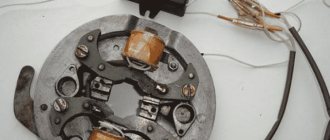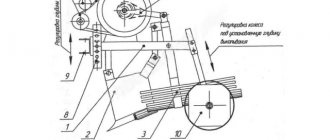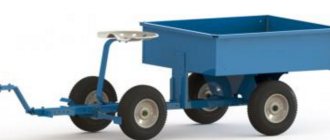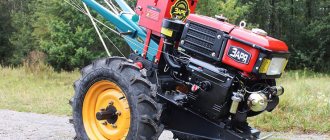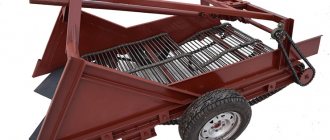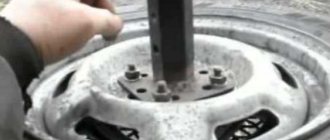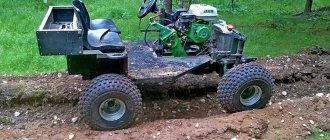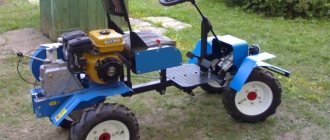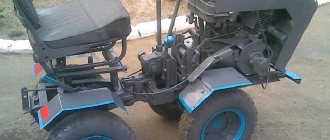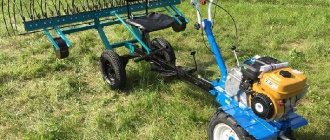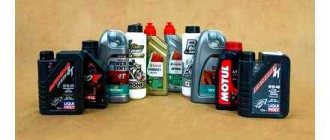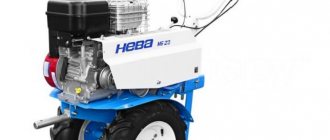It is no secret that in our country there are many craftsmen who are capable of creating all kinds of technological wonders from scrap materials. Of considerable interest are the capabilities of the engine from a walk-behind tractor, which can be equipped with a motorcycle, swamp vehicle, snowmobile and all sorts of other devices. Why are such solutions attractive?
First of all, its accessibility, not to mention the ability of talented mechanics, while doing interesting work, to find practical and original application for their efforts, creating things needed in the household. As for a homemade motorcycle with a walk-behind tractor engine, this solution can be called not only practical, but also quite simple to implement.
You can make a motorcycle from a walk-behind tractor yourself
Do-it-yourself minibike: photo and description of production
Homemade minibike: photo and description of making a homemade product.
Several years ago, while scrolling through pictures of motorcycles on the Internet, I came across an American site dedicated to minibikes - small, homemade motorcycles with engines from various agricultural machinery. In my childhood, we also built something similar, as a rule, it was a children’s bicycle “Mishutka” with a D-6 engine.
Unlike our country, in America this entertainment is on a larger scale - kits for self-assembly, individual components, and tuning kits are sold.
Old minibikes and parts for them have significant value at online auctions. Having an ardent desire to someday do something similar, I began to look for drawings and came across an article in the magazine “Popular Mechanics” dated January 01, 1970 entitled “Tom thumb minibike” with instructions for self-assembling a small motorcycle.
The most valuable thing is that the article provided quite detailed drawings, all that remains is to convert all the dimensions from inches to metric, buy a welding machine, and you can start building!
From the very beginning I decided not to strictly adhere to the original design, retaining only the dimensions of the frame. The vintage Ohlsson and Rice engine from the article was replaced with an equally tiny but modern trimmer engine. In the photo you can estimate the size of the motor in comparison with a wrench of 10. At first, I did not believe that such a tiny unit would be able to move me.
The centrifugal clutch for it, as well as sprockets and chains, were purchased in China.
At first I wanted to buy a ready-made intermediate shaft; they are sold on ebay under the name “minibike jackshaft kit,” but in the end I decided to make it myself. At the same time I installed a small disc brake on it.
The overall gear ratio of both chain drives turned out to be about 16:1. 4-inch wheels, from a garden wheelbarrow. The axles are M12 bolts with adapter bushings for fitting into wheel bearings.
To make the frame, 5 meters of ordinary half-inch water pipe were purchased and a homemade pipe bender was welded.
Then, in one evening in the garage, the frame was bent and welded, the minibike began to look like what was seen in the magazine.
The steering column, like the original, does not have bearings, and a brass washer is placed to facilitate sliding. The axle is still the same M12 bolt. The platform on which the engine is mounted has oval holes for mounting to the frame, thus allowing the chain to be tensioned.
The gas tank is homemade, from a piece of thin-walled pipe, the seat is a piece of plywood, on top of which there are several layers of a fitness mat, and a leatherette cover on top.
The final version, after spray painting, looks like this
The tank volume is about a liter, the minibike weighs a lot, 20 kilograms.
From the moment all the necessary materials and parts were collected to the first test drive, about a month of weekend work passed. Despite the modest engine capacity of 33 cubic centimeters, the minibike gets off quickly and easily accelerates my 90 kg weight to an impressive 20 mph)))
Test drive a homemade minibike:
Spare parts price
Despite the fact that the production of the device stopped long ago, you can still find new spare parts for it that are produced by the industry. Some parts are imported, some come assembled. Supplied in sets:
- Clutch discs.
- Gaskets for power plant and gearbox.
- Nuts.
- Pipes.
- Levers.
The necessary parts can be found on the Internet using store catalogs. Prices for spare parts for the Ant scooter are fair. Here are some examples:
- Clutch disc – 400 rub.
- Kickstarter shaft – 1100 rub.
- Front shock absorber – 1600 rub.
- Gearbox seals – 100 RUR.
- Piston – 2500 rub.
- Gearbox – 14,000 rub.
- Wheel hub – 2000 rub.
Judging by the prices, the device is more than cheap to repair. This is an important operational property for people in rural areas.
How to make a homemade walk-behind tractor with a motorcycle engine, photo video instructions
When deciding to make a walk-behind tractor from a motorcycle engine yourself, you must be guided by an important condition - minimal overhaul and rework, as well as maximum use of used components. Of course, for full-fledged correct work you need to have experience and knowledge, patience and the desire to work. By applying these simple rules, the final product will be an excellent farm transport, adapted to all conditions. In case of problems and malfunctions, the main repair will be a simple replacement of the faulty part.
Making a homemade walk-behind tractor from a motorcycle engine
For normalized operation of the walk-behind tractor, it is necessary to develop a kinematic multi-stage transmission scheme. It allows you to increase the additional ratio, torque and tractive effort. Also, together with the gearbox adapter, the entire circuit provides for the presence of a main gearbox. The most highly efficient engine is obtained by combining the main gear with a geared wheelset.
Thanks to a specialized mechanism, the drive chains are effectively tensioned. This element is attached to the sliders using pins made of steel angles, which, in turn, are able to move freely, stretch, and also weaken the drive chain. A pair of adjusting screws with mounting bolts numbered M10 allows you to perform the above functions.
One of the most complex structures is the main gearbox, made of 10 mm steel plates. Reinforcing disks are located at the mounting bearing location. In order to eliminate the possibility of oil leakage, special continuous welding seams are made. The rear gear wall assumes in its structure the presence of a bracket - a bracket. It is capable of fastening both entire cargo trolleys and agricultural trailers. If you attach the cart to a walk-behind tractor, you will get a real miniature tractor.
The gear cover is made of a five-millimeter steel plate. Thanks to screws number M6, it is freely attached to the body. All straight gear gears are taken from agricultural machines.
Locking the wheels of a walk-behind tractor with a motorcycle engine
An important technical solution regarding the walk-behind tractor is the correct wheel locking. It is imperative to grind the cylindrical neck located on the right half axis next to the splined end. A threaded hole is made on the other axial side. During rotation of the screw number M12, a certain displacement is performed under the action of a cylindrical spring. After the specified moment, the axle shaft moves away from the gears. This is how the wheels are locked.
Motoblock wheels are made from electric car wheels. Sixteen grooves are cut in all disks. Steel plates are welded there. Then jumpers are added, which form the rim of the arable elements.
Plow for walk-behind tractor
The control unit, which allows the plow to freely enter fertile soil, consists of several important parts:
— Welded body type P;
It is into these parts that the direct heel of the plow is inserted. Thanks to technical features, it rotates on a vertical plane, using axial and bushing hinges. The rotation angle is set by the pin number M16. The channel of the particle in question is welded to the rotary heel. (See Do-it-yourself plow for a walk-behind tractor).
A cutting knife is attached to the immediate beam. Its normalized installation is carried out using a standard clamp with a cover plate and two bolts numbered M12 with universal nuts. A V-shaped bracket with an auxiliary wheel is installed on the front of the walk-behind tractor. The main purpose of this element is ease of transportation and unhindered reverse movement.
All direct control of the created transport, that is, the walk-behind tractor, is carried out using a walk-behind mower, a handle and two rods.
Improvement of the chassis
The first thing users of a walk-behind tractor think about is how to make a cart with a seat for it. Using equipment in normal mode using levers requires the application of great physical effort. However, the use of a trailer reduces the stability of the vehicle. This problem can be eliminated by extending the wheelbase. This is done using extensions that are attached to the axle shaft with pins or bolts. Having solved the stability problem, the operator is faced with another issue: the unit is poorly controlled. The differential for the walk-behind tractor helps to give it good maneuverability. This device is made by analogy with components of passenger cars. Homemade unlockers for walk-behind tractors are made using ordinary household tools - an angle grinder, welding and a sharpening machine.
The low weight of the walk-behind tractor causes poor traction between the wheels and the ground. Slipping is a common occurrence when lifting virgin soil, working on wet ground or driving in snow. To avoid slipping, weights are attached to walk-behind tractors.
These devices are divided into the following categories:
- Wheeled. They are discs that are mounted on wheels or hubs. Disks are made monolithic from metal, concrete or hollow, filled with sand. The weight of wheel weights can be 30-70 kg.
- External. Made from any heavy material (steel, lead, concrete). Attached to the body using hooks or bolts. Some craftsmen weld a frame from a corner to the body. Sandbags, bricks, scrap metal and other heavy objects are placed in it.
You can improve the cross-country ability of a walk-behind tractor by installing lugs. The easiest way to make lugs is to make a rim from a strip of metal and weld blades onto it. The rim diameter should be larger than the rims and smaller than that of the tires. The rim is installed with flat tires. After the lug is installed, the wheel is inflated.
You can improve the transmission by installing a homemade variator on the engine. The system of belts and discs will allow you to smoothly change the speed of the unit, without jerking or vibration.
How to make a walk-behind tractor with your own hands from the engine of the planet
The entire direct circuit of the walk-behind tractor fits perfectly for engines such as Minsk (see Homemade walk-behind tractor from a Minsk motorcycle), Voskhod and Ant. Of course, the favorite among all is IZH Planet number 3. To create a walk-behind tractor from this model, it is necessary to make small changes to the overall design.
The engine must be forced to cool. As for the connection, it must be done to its fullest extent through the ignition. The total power is equal to eighteen horsepower. There is a reverse gear, which is installed thanks to the gearbox.
How to make a homemade all-terrain vehicle from a walk-behind tractor
An all-terrain vehicle is understood to mean various means of transportation. These include tractors, snowmobiles, SUVs, and tanks. Today, most of the roads running through rural areas do not have asphalt surface. That is why those who have encountered such a problem are so interested in a homemade all-terrain vehicle from a walk-behind tractor. Having a walk-behind tractor, you can independently make a wheeled all-terrain vehicle that would have high cross-country ability, both over water obstacles and through snow.
We are assembling an all-terrain vehicle, the power unit of which will be a walk-behind tractor. This is the main idea: we remove the steering wheel and wheels from the walk-behind tractor, insert it into the frame, and the driveshafts of the walk-behind tractor go to the axles. One of the key requirements is to prevent a radical alteration of the walk-behind tractor. In other words, I installed the walk-behind tractor into the frame - it turned out to be a floating all-terrain vehicle. I took it off the frame and collected the parts and returned the walk-behind tractor. Here is the result of this idea.
Dimensions and dimensions of a homemade all-terrain vehicle
Overall dimensions of the all-terrain vehicle: length 3100 mm, width 1760 mm, height 1820 mm. Load capacity 200 kg. The maximum speed is from 8 to 12 km/h. The weight of the equipment is 530 kg. The single-level frame is made of profile pipe (60x40x2). The power unit is a MB-3 “Neva” walk-behind tractor with a 7 hp engine.
It also allows you to change three forward gears and one reverse gear. Installed M-412 bridges. Closed discs with bolted fasteners are used. Tires from KAMAZ all-terrain vehicle, tube version, are installed. Steering knuckle from UAZ with CV joint M-2141. Column steering is used - VAZ-1111 "Oka". A transmission and mechanical braking system is installed.
To manufacture the all-terrain vehicle, an MB-3 Neva walk-behind tractor was purchased. I was selected because of the three-speed gearbox, which has a very quiet first gear. The engine is also not very powerful.
Another reason for choosing a walk-behind tractor is the ability to disconnect one of the wheels from the transmission. As a result, we get the ability to disable one of the bridges on a homemade all-terrain vehicle.
The design of the all-terrain vehicle is very simple. All parts of the walk-behind tractor control are located on the rear semi-frame. This allows you to use the walk-behind tractor without modification. As a result, walk-behind control parts were used, which were installed entirely on the frame of the all-terrain vehicle. The exception is the cable and clutch control pedal. The cable along with the lever is removed from the walk-behind tractor, and the clutch cable from the all-terrain vehicle, which is connected to the pedal, is attached.
The principle of operation of the clutch remains the same as on a walk-behind tractor: the all-terrain vehicle drives after pressing the pedal, and stops when it is released. The engine has enough power to drive in third gear to climb steep hills.
In first gear, at minimum speed, maximum traction is achieved, thanks to which the all-terrain vehicle idling can overcome difficult obstacles without straining the engine too much. To increase the maximum speed of the all-terrain vehicle, you need to increase the diameter of the drive pulley by 50%, which will not damage the traction capabilities of the walk-behind tractor.
Part 3. Behind the wheel and Moto - separate components of scooters.
October 1957 - A little information on the dyno starter - a device that acts as a generator and starter on a motor scooter. (Behind the wheel, 1 page).
December 1957 - Description of the chassis of the Tula T-200 passenger scooter. (Behind the wheel, 1 page).
December 1961 - About the K-36 carburetor, which was used on Tourist and TGA-200 (Ant) scooters. (Behind the wheel, 2 pages).
August 1965 - About why the automatic ignition advance was removed. (Behind the wheel, 1 page).
July 1974 - A short article about shock absorbers and their design. In addition, you can find interesting operating diagrams of the shock absorber and general data on the models. (Behind the wheel, 3 pages).
Inverted version of the table.
January 1976 - Detailed information on Soviet tires. There is little to do with scooters, but the types of tires that were used on them are in the table. (Behind the wheel, 3 pages).
March 1976 - General information on spark plugs and some types of their malfunctions. There is a specific connection with scooters only when listing the models of spark plugs and the cars on which they were used. (Behind the wheel, 4 pages).
September 1977 - About the new K-62 carburetor, which replaced the K-36 model and began to be installed on Tulitsa scooters and almost all subsequent scooters and motorcycles of the Tula Machine-Building Plant. (Behind the wheel, 2 pages).
January 1979 - About batteries that were installed on scooters. (Behind the wheel, 1 page).
February 1991 - Carburetor K-65 which replaced the K-62. (Moto, 2 pages).
February 1991 - Some more information about tires. (Moto, 2 pages).
February 1992 - Construction of the front fork, which began to be installed on the Tula 5.951 off-road motorcycle. (Moto, 3 pages).
March 1992 — More about the battery. (Moto, 1 page).
April 1993 - Tula motorcycle gas tank 5.951. (Moto, 2 pages).
July 1993 - Information about old carburetors, of those listed on scooters K-28 and K-36 were installed. (Moto, 2 pages).
April 1994 - Construction of the Ant gearbox and drive suspension, i.e. rear axle as a whole. (Moto, 4 pages).
October 1994 - Information on lamps, in the table at the end there are types of lamps installed on Tula scooters. (Moto, 4 pages).
Same bonus - all articles in one file: part 3.pdf
Design Features
Such devices are considered universal, so more powerful machines are converted to small tractors. With this tool, the owner will be able to save money and get a practical and convenient device. In rural areas, as a rule, difficult roads predominate. And many owners love winter fishing, as well as hiking in the autumn forest to pick mushrooms .
Homemade transport devices consisting of walk-behind tractors have a wide range of types. The positive feature of a mini-tractor is its comfortable use. When creating such a vehicle, it is very important to take into account several features: a shift in the main center of gravity, an increase in the front axle, and the use of a new differential.
Currently, entire kits are available for sale that help increase the number of functions built into the device.
For those who want to drive on snowy roads in rural areas, this option is also well suited. Making a snowmobile with your own hands is quite simple. The most difficult thing in this case is drawing up drawings and mounting the chassis on four wheels. A feature of such transport can be considered the minimum pressure that falls on the surface of the earth. It is best to make specialized ground couplings based on the wheels of the walk-behind tractor.
For owners of heavy vehicles, everything is much easier. The structure of the transport device is almost invisible. In this case, the owner only needs to secure the lugs to the surface of the wheels of the transport model.
There are some features of creating an all-terrain vehicle. The main parts that you need to buy or create yourself for transport based on a walk-behind tractor :
- frame - needed to create mobile transport in difficult areas;
- It is important to use the rear axle when mounting the rear wheels;
- a place for the driver to sit - it should be protected from dirt and water getting from under the wheels when driving;
- lighting that will help you move safely at any time of the day.
An all-terrain vehicle with a base in the form of a walk-behind tractor is created as a single-seat vehicle. The total carrying capacity of such equipment should reach 200 kilograms. The width will be calculated based on the resistance to possible vehicle rollover; most often it starts from 1100 mm.
Modern MTZ, Ugra and Neva walk-behind tractors produced in production include a power exceeding 10 horsepower. This power is quite enough to move at a speed of more than 10 kilometers per hour. When driving through impassable places and swampy areas, the speed can decrease significantly and reach only 1-2 millimeters per hour.
The Complete Trick Scooter Assembly Guide
Building your own stunt scooter isn't easy. There are just as many parts that don't fit together, and improper assembly can easily ruin the parts. This manual contains tips and tricks for assembling your scooter.
Stunt parts are often made to different standards, so there is no manual for building a custom scooter. Most people are advised to use our Custom Scooter Builder tool to make sure all the parts fit together.
The Custom Trick scooter consists of
| 1x Deck | Includes brake and bolt unless otherwise noted |
| 1x Plug | Not all forks fit 110mm wheels |
| 1x rod | Don't forget that a larger rod requires a larger clamp |
| 1x headset | Threadless headset only fits non-threaded plug |
| 1x compression | There are many systems, the most widely used are ICS, HIC and SCS |
| 1x Set of grips | Rod grips fit all rods unless otherwise stated |
| 1x clamp | Remember that an oversized clamp requires an oversized rod |
| 1x Grip tape | Free choice, but some may need to be cut with a utility knife |
| 2x wheels | Remember 1 wheel per package (unless otherwise stated) |
| 4x bearings | Our bearings fit all of our wheels (unless otherwise stated) |
| 2x spacers (8 mm) | Bearings can be destroyed without the use of spacers |
Part designation
Model shown uses ICS system
Tips and tricks from SkatePro
- Ask an adult to help with assembly
- Use the right tool
- Expect it to take at least 3 hours to assemble (if you haven't tried this before)
- Select parts from the same brand and suitable sizes.
- If you choose lightweight parts, keep in mind that they tend to break more easily than heavy ones.
- We recommend that all serious riders choose a threadless headset and a fork with a compression system.
- When you receive your package, check that everything and parts fit together. before starting assembly. (You can return new/unused parts).
- Always tighten all screws and nuts before starting and servicing the scooter as described in the manual. Replace faulty components and spare parts.
- As you continue to use the scooter, the headset will always sag a little. Unfortunately, no more expensive headsets are immune from it, and they will not remain “noise-free” for a long time. (Often helps tighten the compression system)
- Avoid water, sand, wet areas - and too many bad practices.
